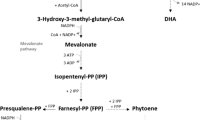Abstract
Culture conditions for growth and docosahexaenoic acid (DHA) production byThraustochytrium roseum ATCC 28210 were investigated with a view to increasing DHA titers. A medium was formulated (Medium 6) which produced a biomass and DHA content of 10.4 g L−1 and 1011 mg L−1, respectively, in a 5-day incubation. A fed-batch culture system was also developed which achieved biomass and DHA titers of 17.1 g L−1 and 2000 mg L−1, respectively, in 12 days.
Similar content being viewed by others
References
Akimoto M, T Ishi, K Yamagaki, K Ohtaguchi, K Koide and K Yazawa. 1991. Metal salts requisite for the production of eicosapentaenoic acid by a marine bacterium isolated from mackerel intestine. J Am Oil Chem Soc 68:504–508.
Bajpai P, PK Bajpai and OP Ward. 1991. Production of docosahexaenoic acid byThraustochytrium aureum. Appl Microbiol Biotechnol 35:706–710.
Bajpai PK, P Bajpai OP Ward. 1991. Optimization of production of docosahexaenoic acid (DHA) byThraustochytrium aureum ATCC 34304. J Am Oil Chem Soc 68:509–514.
Barclay WR. 1992. Process for the heterotrophic production of microbial products with high concentrations of omega-3 highly unsaturated fatty acids. US Patent 5 130 242.
Bimbo AP. 1987. The energing marine oil industry. J Am Oil Chem Soc 64:706–715.
Bligh EG and WJ Dyer. 1959. A rapid method of total lipid extraction and purification. Can J Biochem Physiol 37:911–917.
Braden LM and KK Caroll. 1986. Dietary polyunsaturated fat in relation to mamary carcinogenesis in rat. Lipids 21:285–288.
Chilton FH, M Patel, AN Fontch, WC Hubbard and M Triggiani 1993. Dietary n-3 fatty acid effects on neutrophil lipid composition and mediator production. Influence of duration and dosage. J. Clin Invest 91:115–122.
Chu FE and JL Dupuy. 1980. The fatty acid composition of three unicellular algal species used as food sources for larvae of the American oyster (Crassostrea virginica). Lipids 15:356–364
Cohen Z, A Vonskek and A Richmond. 1987. Fatty acid composition of Sprirulina strains grown under various environmental conditions. Phytochemistry 26:2255–2258.
Connor WE, N Mathan and DS Lin. 1990. Dietary effects on brain fatty acid composition, the reversibility of n-3 fatty acid deficiency and turnover of docosahexaenoic acid in brain, erythrocyte and plasma of rhesus monkey. J Lipid Res 31:237–247.
Davis RJ, JE Holdworth and SL Reader. 1990. The effect of low oxygen uptake rate on the fatty profile of the pleagnious yeastApiotrichum curvatum. Appl Microbiol Biotechnol 33:569–573.
Dyerberg J 1986. Linoleate-derived polynsaturated fattyc acids and prevention of atherosclerosis. Nutr Rev 44:125–134.
Farag RS, FA Khalil, H Salem and LHM Ali. 1983. Effects of various carbon and nitrogen sources on fungal lipid production. J Am Oil Chem Soc 60:795–800.
Gandhi SR and JD Weete. 1991. Production of unstaturated farty acids arachidonic acid and eicosapentaenoic acid by the fungusPythium ultimun. J Gen Microbiol 137:1825–1830.
Guchhait RH, SE Polakis, P Dimroth, E Stoll, J Moss and MD Lane. 1974. Acetyl CoA carboxylase system ofEscherichia coli. Purification and properties of the biotin protein carboxylase, carboxyl transferase and carboxyl carrier protein components. J Biol Chem 249:6633–6645.
Gustafsso U and N Fries. 1956. Nutritional requirements of some marine fungi. Physiol Plant 9:462–465.
Hansson L and M Dostalek. 1988. Effect of cultural conditions on mycelial growth and production of γ-linolenic acid by the fungusMortierella ramaniana. Appl Microbiol Biotechnol 28:240–246.
Holub BJ and CM Skeaff. 1987. Nutritional regulation of cellular phosphatidylinosiol. Meth Enzymol 141:234–244.
Kendrick A and C Ratledge, 1992. Lipids of selected molds grown for the production of n-3 and n-6 polyunsaturated fatty acids. Lipids 27:15–20.
Li ZY and OP Ward. 1994., Production of docosahexaenoic acid byThraustochystrium roseum. J Ind Microbiol 13:238–241.
McReady RM, J Guggolz, V Silviera and HS Owens. 1950. Determination of starch and amylose in vegetables. Anal. Chem 22:1156–1160.
Nagamuna T, Y Uzuka, K Tanaka and H Uzuka. 1987. Differences in enzyme activities ofLipomyces starkeyi between cells accumulating lipids and proliferating cells. J Basic Microbiol 27:35–42.
Neidelman SL. 1987. Effect of temperature on lipid unsaturation. Biotechnol Genet Eng Rev 5:245–268.
Peberdy JF and DK Tooner. 1975. Effect of nutrient starvation on the utilization of storage lipids inMortierella ramanniana Microbiols 13: 123–131.
Radwan SS and AH Soliman. 1988. Arachidonic acid from fungi utilizing fatty acids with shorter chains as sole sources of carbon and energy. J. Gen Microbiol 134:387–393.
Ratlege C. 1989. Microbial Lipids, vol 2. pp 267–275, Academic Press, London.
Sajbidor J, S Dobronova and M Certik. 1990. Arachidonic acid production byMortierella sp S-17. Influence of C/N ratio. Biotechnol Lett 12:455–456.
Sajbidor J, D Kozelouhova and M Certik. 1992. Influence of some metal ions on the lipid content and arachidonic acid production byMortierella sp. Folia Microbiol 37:404–406.
Stinson EE, R Kwoczak and MJ Kurantz. 1991. Effect of cultural conditions on production of eicosapentaenoic acid byPythium irregulare. J Ind Microbiol 8:171–178.
Stinson EE, DJ O'Brien and EW Wessinger. 1991. Effect of nutrition on growth, and EPA production byPythium irregulare. INFORM 2: 355.
Ward OP. 1995. Microbial production of long-chain PUFAs. INFORM 6:683–688.
Weete JD, 1980. Lipid Biochemistry of Fungi and Other Organisms. pp 9–48. Plenum Press, New York.
Yano Y, A Nakayama, H Sato and K Ishihara. 1994. Production of docosahexaenoic acid by marine bacteria isolated from deep sea fish. Lipids 29:527–528.
Yongmanitchai W and OP Ward. 1989. Omega-3 fatty acids: alternative sources of production. Proc Biochem 24:117–125..
Author information
Authors and Affiliations
Rights and permissions
About this article
Cite this article
Singh, A., Ward, O.P. Production of high yields of docosahexaenoic acid byThraustochytrium roseum ATCC 28210. Journal of Industrial Microbiology 16, 370–373 (1996). https://doi.org/10.1007/BF01570118
Received:
Accepted:
Issue Date:
DOI: https://doi.org/10.1007/BF01570118




